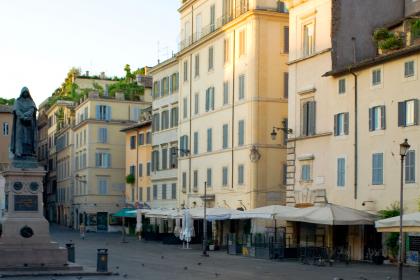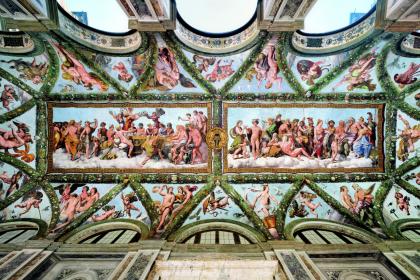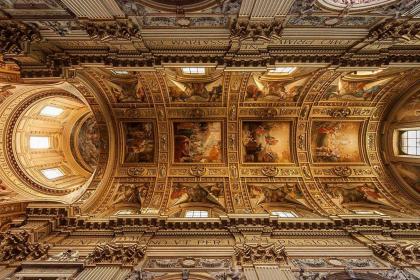
Built at the behest of Cardinal Girolamo Capodiferro (1502-1559), the construction of Palazzo Spada started at the end of 1548, by the architect Bartolomeo Baronino (1551-1554) of Casale Monferrato, on pre-existing buildings of the owner family.
By the Jubilee of 1550, the construction works were almost completed. The execution of the stucco decorations that embellish its facade and the courtyard were the work of two specialized artistic workshops, led respectively by Giulio Mazzoni and Diego di Fiandra and by Tommaso del Bosco and Leonardo Sormani, and to the same pictorial cycles of the Noble Floor.
In the following century, Palazzo Capodiferro passed to Cardinal Bernardino Spada (1594-1661), who, after the purchase, began a series of works that lasted thirty years. They endowed the palace with a new and more enjoyable appearance.
The rich façade has niches framed by garlands of flowers and fruit and grotesques inside which statues of Illustrious Men for the history of Rome are positioned, including Romulus, Caesar, and Trajan. The last floor displays marble squares with the synthesis of the major enterprises of the Illustrious Men.
The Secret Garden preserves the most sensational Baroque artifice in Rome: the illusionist Colonnade, or Perspective, created by Francesco Borromini for Cardinal Bernardino Spada, in 1653. The Colonnata bears a refined moral warning to those who trust the appearances of the world too much. It deceives the viewer for its dimensions which are very different from how they are perceived by the eye, being the skillful product of mathematical and perspective calculations. Through the raising floor and the convergent walls, the great architect created a much deeper space. An incredible and unique architectural trompe l'oeil because the Colonnata is only 9 meters long.
On the first floor of the Palace, in a seventeenth-century wing, is the Galleria Spada which, within four rooms, houses a famous collection of Baroque paintings, created during the seventeenth century by Cardinals Bernardino and Fabrizio Spada.
The magnificent building is also the seat of the State Council.
Campo de’ Fiori

 Condividi
Condividi
Villa Farnesina

 Condividi
Condividi
Basilica of Sant'Andrea della Valle

 Condividi
Condividi
Information
Palazzo Spada houses the Council of State.
Visits to the Piano Nobile are therefore permitted only when compatible with institutional activities and upon written request.
Please refer to the "Guided Tours" section of this page: www.giustizia-amministrativa.it
 Condividi
Condividi
Location
To find out about all accessibility services, visit the Rome accessible section.











































